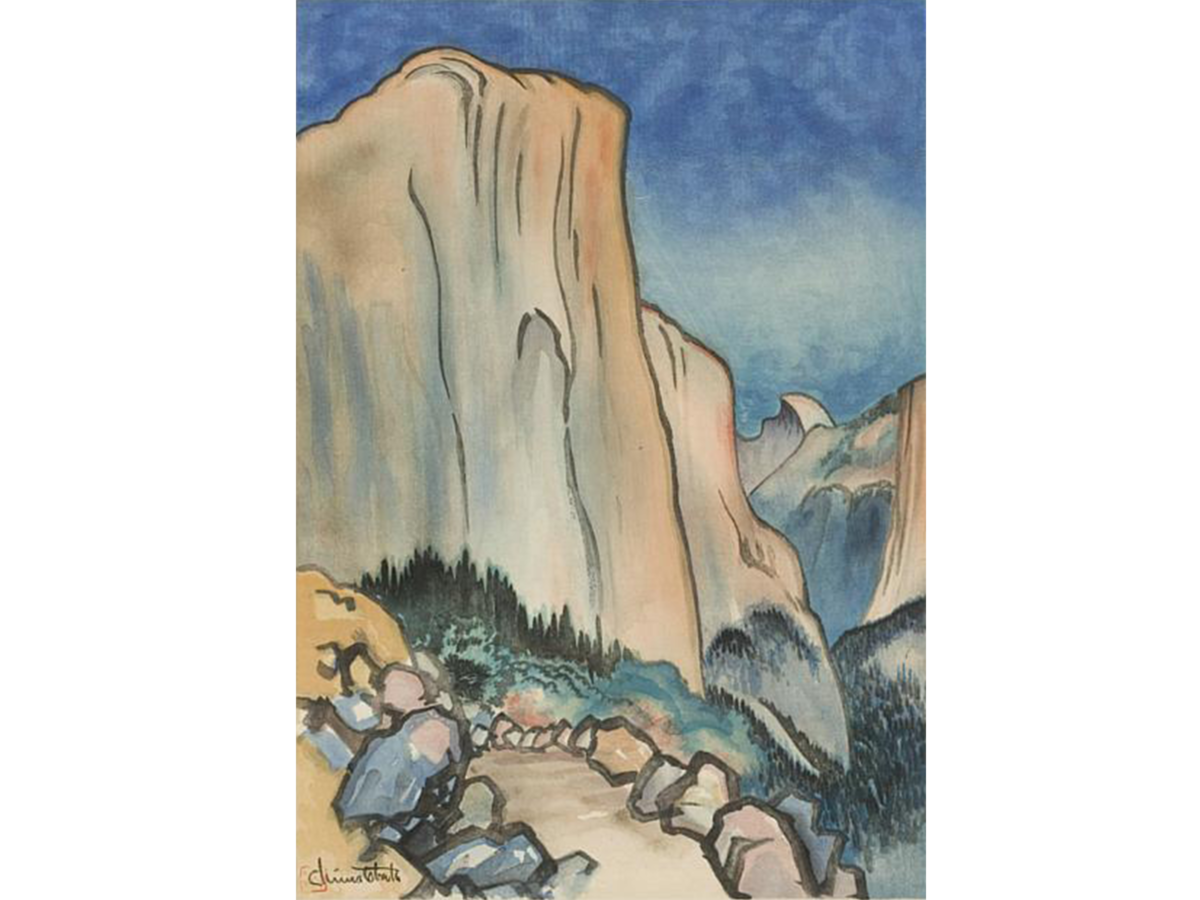Activity
Environmentalism: “Can Art Save the World?”
Objective: Students will consider the ways art can be used as activism in the context of environmentalism and National Park preservation.

El Capitan: Yosemite National Park, 1930, by Chiura Obata
Chiura Obata was a devoted environmentalist throughout his life. His signature landscapes celebrate the natural world. His artwork invites viewers to look upon nature with gratitude and thoughtfulness to understand its value.
Common Core Standards
Earth and Human Activity
ESS3.C Human activities in agriculture, industry, and everyday life have had major effects on the land, vegetation, streams, ocean, air, and even outer space. But individuals and communities are doing things to help protect Earth’s resources and environments.
Visual Arts
Visual Arts 3.0 Understanding the Historical Contributions and Cultural Dimensions of the Visual Arts.
4.VA:Re7.2 Interpret art by analyzing use of media to create subject matter, characteristics of form, and mood.
Visual Arts 5.0 Connecting and Applying What is Learned in the Visual Arts to Other Art Forms and Subject Area and to Careers
5.VA:Cn11 Identify how art is used to inform or change beliefs, values, or behaviors of an individual or society.
6.VA:Re7.2 Analyze ways that visual components and cultural associations suggested by images influence ideas, emotions, and actions.
Media Arts
6.MA:Cn11 Discover and share ideas for media artworks using play and/or experimentation.
Research and show how media artworks and ideas relate to personal life, and social, community, and cultural situations, such as personal identity, history, and entertainment.
English Language Arts
6-12.SL.1 Engage effectively in a range of collaborative discussions (one-on-one, in groups, and teacher-led) with diverse partners on grade appropriate topics and texts, building on others’ ideas and expressing their own clearly and persuasively.
Materials
PBS film Clip: “The National Parks: America’s Best Idea”
Student writing worksheet (download from sidebar above)
Internet access
Whiteboard
Large blank paper for final project
Art supplies
Vocabulary
Environmentalist: (noun) A person who is concerned with or advocates the protection of the environment.
Environmental Art: (noun) “For centuries, the landscape’s appearance in art was meant to construe either awe for our natural world, or as a background subject for the documentation of human narratives. In the 20th century, alongside rising global concerns surrounding the state of the environment’s health, and our impact as humans upon it, many artists started creating works in collaboration with the physical world to draw attention to ecological issues as well our relationship and contribution to them. As a more defined concept, Environmental art has gained more traction since the 1990s when artists began to think about their surroundings not just in terms of lived or built space, but as a cohesive system in which humans have a central part to play.”
Procedure
- Invite students to consider the definition of environmental art and environmentalism
- Use classroom participation to craft definitions of the two terms
- Compare your class’s definition to the provided definition in the teacher packet available for download in the sidebar.
- Introduce Chuira Obata as an environmental artist connected to the National Parks through his works of Yosemite.
- Have your class watch this PBS Film Clip of Chiura Obata’s biography.
- Give classroom directions for the following written assignment. Students will complete the short writing prompts found in the Student Writing Worksheet
- How did you develop a relationship with nature?
- Where and how do individuals get their view of nature?
- Is it necessary to appreciate nature in order to preserve it
- Once students are finished, share ideas in groups of two or more, and ask students to share what they discussed. Record comments on white board.
- Pair students into groups again to discuss the following questions either by writing answers on the student worksheet, or by responding verbally within groups.
- Ask students to consider what environmental issues are occurring now, such deforestation, wildfires, rising seas, etc.
- Ask students to consider what tools environmentalists have to preserve nature.
- Take comments from each group and continue jotting down answers on whiteboard
- Optional take-home assignment: Have students research an environmentalist and/or find one art piece about the environment to share.
Conclusion
- Allow group and class sharing of homework assignment if applicable
- Prepare for Final project
- Option 1 – Invite students to create their own individual environmental activist art piece.
- Option 2 – Have groups complete a poster board promoting environmentalism.
- What are the key issues faced by environmentalists?
- What tools can environmentalists use? (Protests, art, videos, movies)
- Include notable environmentalists
- Draw their own environmental art
Extension
- Students have the option to research individual environmentalists and complete writing assignments.
- Teachers can introduce the National Parks and American history using this resource by PBS
- Teachers can consider adding a discussion about environmental racism, or have the class primarily focus on environmentalists of color.




